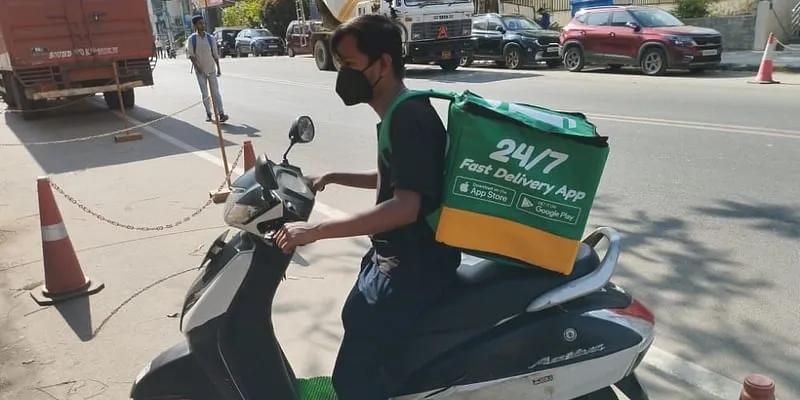Uncle Delivery wants to give SMEs a leg up by removing last-mile hurdles
Since being founded by Sourabh Chatterjee in June 2021, it has grown to have a driver base of over 86,000 drivers and an active user base of near 24,000 users.
An ecommerce company is as good as its last order. This is defined by how it fulfills last-mile delivery or the last leg of its supply chain. Last-mile logistics should be covered at lightning-fast speed to churn out a satisfied customer base.
In a bid to empower Small and Medium Enterprises (SMEs) to do more, Sourabh Chatterjee began in June last year. Since then, it has grown to have a driver base of over 86,000 drivers and an active user base of near 24,000 users.
Currently Uncle Delivery operates in Bengaluru, Mumbai, Delhi, and Hyderabad and employs nearly 235 people.

Uncle Delivery delivery partner
“They don't have to deal with the struggles of negotiating prices, settling for an unsuitable vehicle due to non-availability nearby. Uncle delivery brings to them convenient and low-cost solutions at their doorstep, that a traditional logistics market fails to offer,” shares Sourabh Chatterjee, Executive Director, Uncle Delivery.
How does it work?
There are two versions of the app depending on if you are a User or a Driver. In the User version, anyone can place an order for the movement of their goods from anywhere within a given city/region. The order will be received by the nearest partners who are registered and verified by Uncle Delivery on its Uncle Delivery Driver app. Once a driver accepts an order, they get connected with the user to complete the pickup and drop off the goods.
”Through AI and on-ground market surveillance, we match the User request with the best-priced Supply (driver) to execute the order, and for the same, we charge the Commission/lead fees from our Partner (driver),” says Sourabh.
Drivers are verified by Uncle Delivery through verification of personal documents as well as details of the vehicle used by the driver.
Uncle Delivery is at the crux of a very lucrative business. Intracity logistics through road is projected to become a $372 billion market by 2026, according to a Redseer report. The study also shows that 60% of the intra-city logistics will be driven by on-demand business. This refers to the process of providing services to customers on the basis of their requirements. On-demand businesses are considered to be more cost-effective than other existing business models as a lot of time is saved on delivery and less capital is spent on developing your own fleet.
By following this type of business model, Uncle Delivery is able to cater to not just a specific target audience but anyone ranging from individuals to SMEs. It also considers itself an aggregator platform, similar to companies like Swiggy and Zomato which do not have fleets of their own, rather they onboard personnel to execute their services.
Funding and way ahead
Investments into Uncle Delivery are led by an undisclosed group of private investors. It considers Porter to be its closest rival. This is primarily because Uncle Delivery focuses on the movement of goods within a given region and not between cities. “However, the current focus is only on same-day, intra-city on-demand delivery. With the case of Porter, their main business is also intracity goods movement, quite similar to ours,” says Sourabh.
Uncle Delivery offers users services across three categories–two Wheelers (for smaller goods), three wheelers for slightly larger goods and trucks. “The different vehicle types in our platform are priced in such a way that we will be a cheaper (rightly priced) alternative in the market. So, users will find our platform to be attractive,” he adds.
According to Sourabh, by Year-To-Date (YTD) July’23 the company has set the trajectory of GMV of Rs 1.5 Cr per month, with a forecast of INR 43 Cr of GMV by the end of FY March’23.
The gig economy
Currently, the gig economy in India is looking to be formalised. A study from NITI Aayog estimates that nearly 77 lakh workers were engaged in the gig economy in 2020-21, and this number is estimated to grow to nearly 2.35 crore workers by 29-2030.
The report titled India’s Booming Gig and Platform Economy further said gig workers are expected to form 6.7% of the non-agricultural workforce or 4.1% of the total livelihood in India by 2029-30.
While its competitors often penalise workers, Uncle Delivery does not implement this practice. “We offer affordable services to our users with high earnings for drivers,” says Sourabh, adding that the company does not penalise drivers for inactivity and does not impose minimum login hours.
“To ensure drivers have a good earning, apart from the price of the order (post deducting our commission), we also provide milestone-based incentives to drivers. A highly active driver on our platform will be able to earn much more than what is possible on other platforms,” he further explains.
Edited by Akanksha Sarma








